
BCG’s survey of 1,400+ C-suite executives reveals that GenAI is quickly changing the way companies do business—but 90% of leaders are still waiting for it to move beyond the hype or pursuing limited experimentation.
2023 marked a turning point for AI. ChatGPT, OpenAI’s wildly popular chatbot, became one of the fastest-growing web platforms of all time and now receives 1.5 billion visits every month. Bing Chat, Bard, and other generative AI (GenAI) competitors quickly followed.
While almost all executives now rank AI and GenAI as a top-three tech priority for 2024, 66% of leaders are ambivalent or dissatisfied with their progress on AI and GenAI—and only 6% have begun upskilling in a meaningful way. How can executives set up their organizations to seize the business opportunities that GenAI offers?
To answer this question, we surveyed 1,400+ C-suite executives in 50 markets and across 14 industries. Their responses provided us with a number of insights.
Learn More About BCG X
AI Is a Top Strategic Priority
AI has shot to the top of the executive agenda. GenAI has ushered in a new world of business opportunities—and executives are eager to capitalize on them:
- 71% of the leaders we surveyed say that they plan to increase their company’s tech investments in 2024, up from 60% in 2023, and an even larger percentage (85%) say that they will increase their spending on AI and GenAI in 2024.
- 89% of executives rank AI and GenAI as a top-three tech priority for 2024.
- 54% of leaders expect AI to deliver cost savings in 2024. Of those, roughly half anticipate cost savings in excess of 10%, primarily through productivity gains in operations, customer service, and IT.
In every step of the AI journey, we got more and more efficient. The difference with GenAI is that the level of efficiency is so much higher. We’re seeing a substantial increase in efficiency, more than in any of the other steps that we have done in the last ten years. Over time, this will have a huge impact.
Hans Vestberg, CEO of Verizon
But Many Companies Are Falling Behind
Although the uptick in investment is promising, most organizations aren’t doing enough to realize the full benefits of AI. The executives who expressed dissatisfaction with their organization’s progress on AI and GenAI highlighted several challenges, including a shortage of talent and skills (62%), unclear investment priorities (47%), and the absence of a strategy for responsible AI (42%):
- Only 6% of companies have managed to train more than 25% of their people on GenAI tools so far.
- 45% of leaders say that they don’t yet have guidance or restrictions on AI and GenAI use at work.
In short, despite realizing the need to increase their investments in AI, too many organizations are slow to embrace the revolution. Consider this: two-thirds of the executives we surveyed believe that it will take at least two years for AI and GenAI to move beyond the hype, and 71% are focused on pursuing limited experimentation and small-scale pilots. Some 90% of leaders fall into one of these two categories. We call them observers.
But this is not a time to wait and see. Winners recognize that GenAI is here to stay and that extraordinary opportunities for productivity gains—as well as topline growth—are within reach right now.
The potential just keeps growing as I look forward. Everyone is going to be looking for the next thing they can use their people for—to repoint them to higher-value work—with AI as an augmenter of many, many roles.
Alex Cook, Head of strategic capabilities (technology, data, AI, strategy, ventures), New York Life Insurance Company
What Sets the Winners Apart
Our analysis, reinforced by several in-depth interviews of top executives, indicates that a relatively small percentage of companies are setting themselves up for success with AI—while others are falling perilously behind. Five characteristics set the winners apart.
Winners invest in productivity and topline growth. Of the companies that expect to see cost savings from AI and GenAI in 2024, roughly half anticipate more than 10% in cost savings. In concrete terms, that would mean savings of $1 billion for a company with $10 billion in revenues.
Organizations that plan to invest more than $50 million in AI/GenAI next year are 1.3 times as likely as their peers to expect cost savings in 2024—and 1.5 times as likely to anticipate more than 10% in cost savings. But the winners won’t just bank these savings. They’ll reinvest them in the business to create new revenue streams and drive further growth. This proactive approach to reinvestment should be every company’s North Star in its strategic planning.
There are a lot of positive, growth- and margin-oriented projects that are not just productivity projects. We can use AI and GenAI for promo optimization, markdowns, written media, personalization, pricing—overall margin improvement.
Thierry Garnier, CEO, Kingfisher
Learn More About GenAI
Winners are upskilling systematically. To reap the rewards of AI, leading companies ensure that teams know how to use it most effectively—and scale up their reskilling muscle accordingly. Most leaders agree that GenAI will create new roles in their companies and expect that, on average, almost half of their workforce will need to be reskilled in GenAI over the next three years.
Winning companies already have a head start in adopting the necessary technologies. BCG's 2023 DAI study found that leading firms typically have three times as many full-time employees upskilled on AI as others do. Our survey yielded a similar finding: 21% of organizations spending upward of $50 million on AI and GenAI next year have already trained more than a quarter of their people on the relevant tools (versus just 6% of companies overall).
Most executives, in fact, report that only 1% to 10% of their workers are currently trained on GenAI tools. Executives need training, too, as 59% of leaders surveyed say that they have limited or no confidence in their executive team’s proficiency in GenAI.
Winners are vigilant about cost of use. With GenAI’s rapidly broadening accessibility, companies can expect swift adoption—and rising related costs—as use of these tools spreads. Currently, however, too few executives are thinking this far ahead. Only 19% of those surveyed view cost as the top concern when choosing an AI/GenAI solution.
In organizations where GenAI is not well implemented, the potential run cost is huge, given the technology’s fast uptake. The associated costs will only grow as companies launch customized projects at scale. Executives must proactively manage usage costs if they don’t want to deal with an expensive surprise later on.
Winners build strategic relationships. AI leaders understand that the technology and the solutions it makes possible are moving fast. Only 3% of executives consider preexisting partnerships a priority when looking for AI solutions. The winners are actively building a partnership ecosystem with multiple companies, including software providers and GenAI startups, in order to gain access to cutting-edge technology and create near-term value.
What’s impressive is the enthusiasm and the demand from customers to harness generative AI. We see tremendous engagement and little hesitancy to integrate this new technology.
Christian Klein, CEO, SAP
Winners implement responsible AI (RAI) principles. The sheer speed of GenAI adoption makes RAI more important than ever—especially as threats in areas such as cybersecurity emerge. Organizations must be proactive in addressing RAI issues, no matter where they are on their AI journey.
BCG research has shown that organizations whose CEOs participate in RAI initiatives realize 58% more business benefits than those whose CEOs are uninvolved. Of the companies in our survey that plan to invest more than $50 million in AI and GenAI in 2024, 27% put the CEO in charge of their RAI strategy (versus 14% overall).
Looking Ahead
Not long ago, only AI experts, data scientists, and machine learning engineers could implement AI. Now GenAI is instantly available to any employee who wants to experiment with it.
Thierry Garnier, CEO of Kingfisher, describes how his company adapted to GenAI: “At the beginning, we restricted all access to ChatGPT and similar large-language models, and we had a lot of complaints. But you have to trust people and have clear principles. So we worked together across functions, including HR and IT, and gradually provided access, established rules, and offered mandatory training on best practices and dangers—and these principles allowed us to have a path forward.”
The genie is out of the bottle. If 2023 was the year when AI became democratized, 2024 is the year to turn GenAI’s magic into business impact. We recommend three value plays to maximize GenAI’s potential:
- Deploy GenAI in everyday tasks to realize 10% to 20% productivity potential. Select and test GenAI tools, deliver massive upskilling, roll out solutions to support workers in day-to-day tasks, and carefully evaluate the costs of deployment.
- Reshape critical functions for 30% to 50% enhancement in efficiency and effectiveness. Anticipate the impact of GenAI on your workforce and core functions, create new roles, reallocate budgets, and guide a series of pilots that can reliably scale up.
- Invent new GenAI business models to build a long-term competitive advantage. Develop a strong customer-centric approach, and leverage first-party data and intellectual property to create interactions that customers can't find anywhere else.
By pursuing opportunities in these areas, organizations can increase productivity, enhance efficiency and effectiveness, boost revenue, and build a long-term competitive advantage.
The accompanying slideshow offers a detailed view of our survey results.

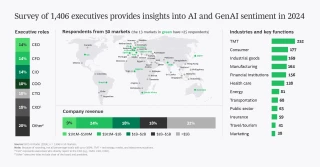
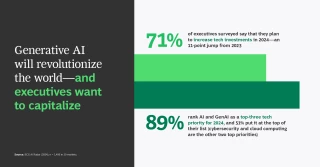
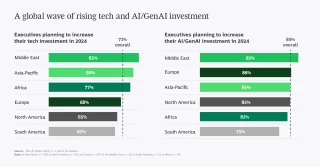
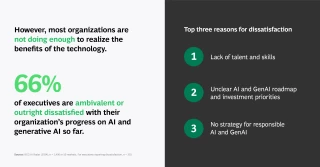
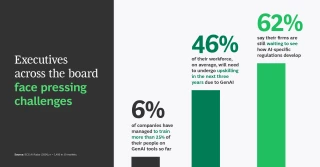
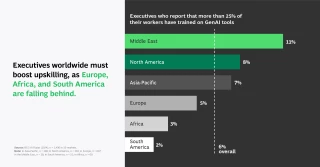
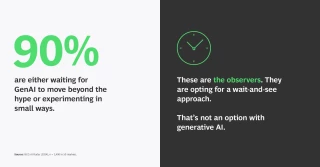

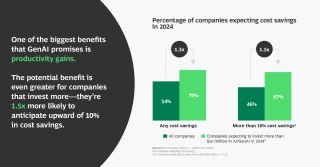
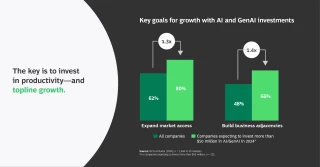
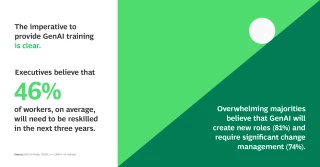
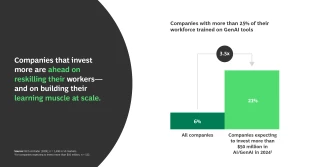
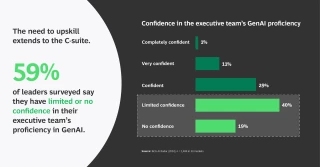
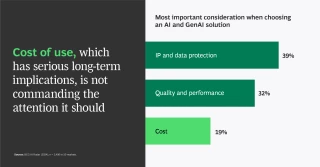
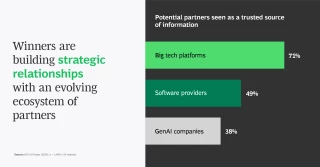
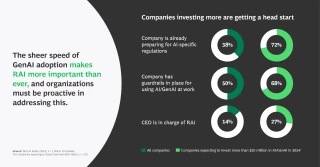
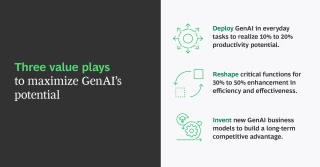
1 / 18